-
Product Name
Anti-MOB1B / MOBKL1A antibody
- Documents
-
Description
Mouse monoclonal to MOB1B / MOBKL1A
-
Tested applications
IF, ICC/IF
-
Species reactivity
Human MOB1B / MOBKL1A
-
Alternative names
MOB kinase activator 1B antibody; Mob1b antibody; 1110003E08Rik antibody; AU015450 antibody; B230364F10 antibody; Mobkl1a antibody; MOB1 antibody; Mps One Binder kinase activator-like 1A antibody; mob1 homolog 1A antibody; MATS2 antibody; MOB4A antibody; MOBKL1A antibody; Mobkl1a antibody; AU015450 antibody; B230364F10 antibody; 1110003E08Rik antibody
- Immunogen
-
Isotype
Mouse IgG2a
-
Preparation
This antibody was obtained from a mouse immunized with purified, recombinant Human MOB1B / MOBKL1A (rh MOB1B / MOBKL1A; Q7L9L4; Met1-Arg216). The IgG fraction of the cell culture supernatant was purified by Protein A affinity chromatography.
-
Clonality
Monoclonal
-
Formulation
0.2 μm filtered solution in PBS
-
Storage instructions
This antibody can be stored at 2℃-8℃ for one month without detectable loss of activity. Antibody products are stable for twelve months from date of receipt when stored at -20℃ to -80℃. Preservative-Free.
Sodium azide is recommended to avoid contamination (final concentration 0.05%-0.1%). It is toxic to cells and should be disposed of properly. Avoid repeated freeze-thaw cycles. -
Applications
ICC/IF: 10-25 μg/mL
-
Validations

MOB1B / MOBKL1A Antibody, Mouse MAb, Immunofluorescence
Immunofluorescence staining of Human MOBKL1A in Hela cells. Cells were fixed with 4% PFA, permeabilzed with 0.3% Triton X-100 in PBS, blocked with 10% serum, and incubated with mouse anti-Human MOBKL1A monoclonal antibody (15 µg/ml) at 4℃ overnight. Then cells were stained with the Alexa Fluor® 488-conjugated Goat Anti-mouse IgG secondary antibody(green) and counterstained with DAPI(blue). Positive staining was localized to cytoplasm.
-
Background
MST1 and MST2 are the mammalian Ste20-related protein kinases most closely related to Drosophila Hippo, a major regulator of cell proliferation and survival during development. Overexpression of MST1 or MST2 in mammalian cells is proapototic. MST1 and MST2 activity increases during mitosis, especially in nocodazole-arrested mitotic cells, where these kinases exhibit both an increase in both abundance and activation. MST1 and MST2 also can be activated nonphysiologically by okadaic acid or H2O2. The MOB1B and MOBKL1B polypeptides, homologs of the Drosophila MATS polypeptide, are identified as preferred MST1/MST2 substrates in vitro and are phosphorylated in cells in an MST1/MST2-dependent manner in mitosis and in response to okadaic acid or H2O2. MST1/MST2-catalyzed MOB1B/MOBKL1B phosphorylation alters the ability of MOB1B/MOBKL1B to bind and regulate downstream targets such as the NDR-family protein kinases. Thus, MOB1B/MOBKL1B phosphorylation in cells promotes MOB1B/MOBKL1B binding to the LATS1 kinase and enables H2O2-stimulated LATS1 activation loop phosphorylation. Most importantly, replacement of endogenous MOB1B/MOBKL1B by a nonphosphorylatable mutant is sufficient to accelerate cell proliferation substantially by speeding progression through G1/S as well as mitotic exit.
-
References
- Ota T, et al. (2004) Complete sequencing and characterization of 21,243 full-length human cDNAs. Nat Genet. 36(1):40-5.
- Gerhard DS, et al. (2004) The status, quality, and expansion of the NIH full-length cDNA project: the Mammalian Gene Collection (MGC). Genome Res. 14(10B):2121-7.
- Devroe E, et al. (2004) Human Mob proteins regulate the NDR1 and NDR2 serine-threonine kinases. J Biol Chem. 279(23):24444-51.
- Praskova M, et al. (2008) MOB1B/MOBKL1B phosphorylation by MST1 and MST2 inhibits cell proliferation. Curr Biol. 18(5):311-21.
Related Products / Services
Please note: All products are "FOR RESEARCH USE ONLY AND ARE NOT INTENDED FOR DIAGNOSTIC OR THERAPEUTIC USE"
